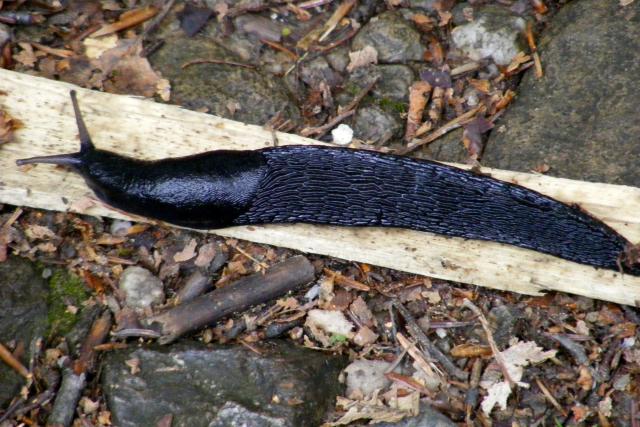Scientific classification
Kingdom: Animalia
Phylum: Mollusca
Class: Gastropoda
Family: Arionoidea
Subfamily: Arionidea
Genus: Arion
Species: Arion ater
Distribution
The black slug is native to western and central Europe, from Scandinavia to Spain and from Ireland to Austria and the Czech Republic. It has been introduced to southeastern Australia and to some part of North America (Newfoundland, Alaska).
Physical characteristics
The size of the slug is from 10 to 15 cm. The colour variation is due to the differences in temperatures. Usually black coloured but sometimes happed to be red, dark-brown, light-orange and even white. Young specimens of black slug do have a brown colour, which is later lost. It has two sets of tentacles: the larger, upper tentacles are sensitive to light, but they cannot differentiate colours; the smaller, lower tentacles are used for smell. Both tentecles can be retracted when the slug is danger. The mouth is on the underside of the head, and it contains a toothed tongue (radula), that has up to 27000 teeth on it. The radula is used to rasp food into the slug's mouth. Behind the head, the smooth area is called the mantle, and it contains a breathing hole on the right hand side (pneumostone). It protects the rest of the organs. Its leg is muscular and covered by mucus. Slugs do wavy movements for getting forward.
Nutrition
The black slug is omnivorous, and its diet includes fungi, carrion, earthworms, leaves, stems, dead plant material and dung. The food is shredded into tiny pieces by the radula and is then digested by enzymes.
Habits
The slug covers itself with thick foul-tasting mucus which is for defense against predator animals, for keeping itself wet, for promoting movement and has a role in reproduction as well. If something comes up to its body it gets into defensive state by curling up. Its horn is able to rebuild. Black slugs are active at night, but appear after raining at daytime as well. In case of a cold or dry weather it digs itself into the soil.
Reproduction
Black slugs get puberty at the age of 1 year. It’s a hermaphrodite, produces sperm and ovum as well, but for reproduction breeding is needed. Slugs lay their eggs in nodes below the soil.
Hatching time depends on the temperature, but can be 4−6 weeks. The young slugs are 10 mm long and yellowish grey in colour, with a darker grey head. It takes up to a year for the young to reach maturity, and the adults have a lifespan of about two years.
Ecological relationships
Black slug is often a host of small mites. Mites eat mucus of slugs.There are predators which eat it. For example the urchin, the badger, the fox and various birds. Seeds and spores are dispersed by slugs, as they get caught in the mucus or slime as a slug moves and are transported for varying distances before being deposited in new sites when the accumulated debris falls off the animal.
Its role in the soil
In case of a cold or dry weather it digs itself into the soil. Slugs lay their eggs in nodes below the soil and come up to the surface from there. By processing decaying plant and fecal material, it helps to recycle the organic matter and nutrients back into a form that can be used by other organisms. This also aids in the maintenance of soil fertility.
Endangerment
Besides the usefulness of the trace of mucus, it jeopardizes the animal as some predators follow the trace and eat up the slug; however, subsistence of the genus is not endangered. It’s not protected, rather proliferated and gnaw the parts of plants. Due to its harmful behavior, black slugs are often killed by gardeners.
Human use
Arion ater was used as grease to lubricate wooden axle-trees or carts in Sweden.
http://www.treesforlife.org.uk/forest/species/blackslug.html
http://en.wikipedia.org/wiki/Black_slug
http://hu.wikipedia.org/wiki/Fekete_csupaszcsiga
Csodálatos állatvilág, Mester Kiadó Kft., 2000
